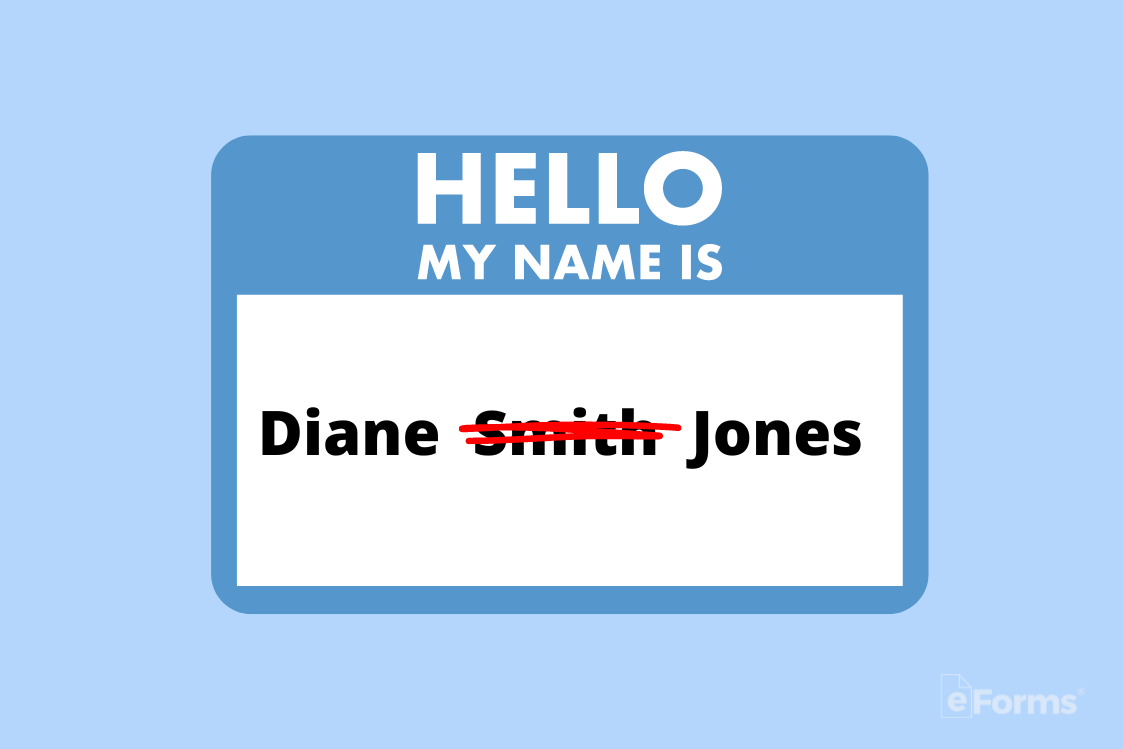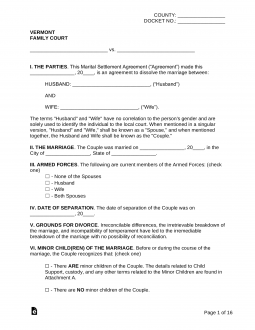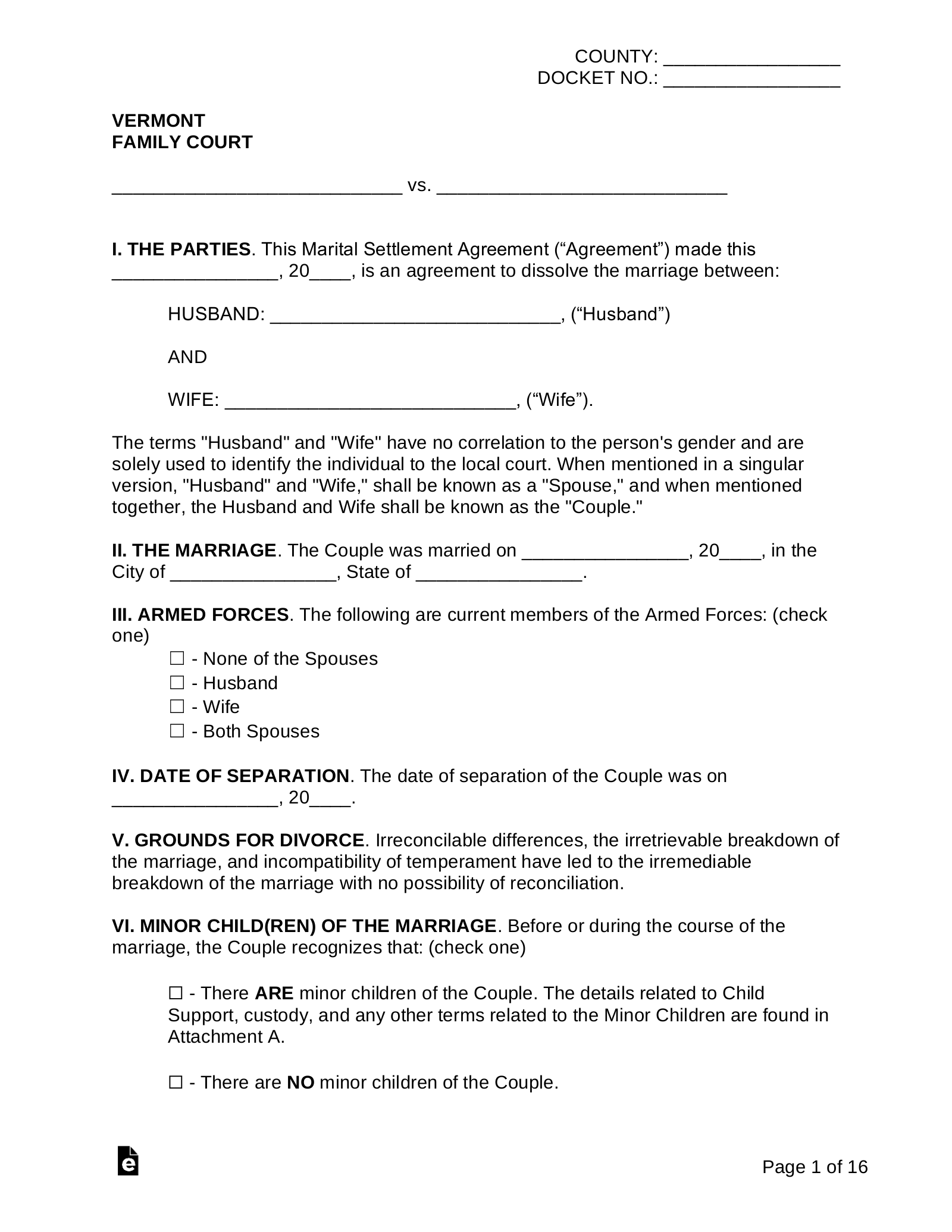Updated July 10, 2023
A Vermont marital settlement agreement is a document used to relay an understanding and agreement on all terms related to the dissolution of a marriage. In Vermont, a couple may file for a stipulated divorce, which means that both parties agree on all aspects of the marriage, including the division of property, the distribution of child support (if applicable), and the payment of spousal support. The spouses will discuss the appropriate settlement and relay the terms in a completed marital settlement agreement. While this is not a form someone files with the court in Vermont, it can help ensure both parties are on the same page before completing the official court forms. To file for a stipulated divorce in Vermont, the couple will need to complete a Final Stipulation, and if they have children, a Parental Rights and Responsibilities Stipulation; the settlement agreement can enable the spouses to prepare for the completion of both forms.
Table of Contents |
Divorce Laws
Statutes – Title 15, Chapter 11 (Annulment and Divorce)
Alimony (15 V.S.A. § 752) – The court may order that maintenance (alimony) be paid either temporarily to rehabilitate the recipient or indefinitely. The following factors will be taken into consideration when establishing the amount and duration of maintenance payments:
- The spouse seeking maintenance’s resources, property following divorce, independent earning ability;
- The time and money needed to acquire the skills necessary to find sufficient employment;
- Standard of living and duration of the marriage;
- Age, emotional condition, and physical condition of both spouses;
- The needs of the spouse providing maintenance;
- Inflation;
- The amount of child support that goes to the spouse as a custodian.
Child Support (15 V.S.A. § 659) – In establishing a child support order, the court will determine the following:
- Financial resources and needs of child, custodial parent, and non-custodial parent;
- Standard of living prior to divorce;
- Physical and emotional condition of child;
- Child’s educational needs;
- Inflation;
- Cost of education of either parent for the purpose of increasing earning capacity;
- Cost of travel to maintain contact between parent and child;
- Any other relevant factors.
The Agency of Human Services has provided the Sole and Split Custody Table to establish a support guideline. The table lists the percentage of combined income that parents living in the same household ordinarily spend on their child.
Child Support Calculator – childsupportcalculator.ahs.state.vt.us
Division of Property (15 V.S.A. § 751(b)) – Vermont is one (1) of forty-one (41) states that use equitable distribution law. This means that the court will divide the property as they deem just and fair as opposed to splitting all marital property evenly between the parties. The court will take into account the following factors in establishing a property settlement for the division of assets:
- Duration of the marriage;
- The age and health of each spouse;
- The earning ability of each spouse;
- The income of each spouse;
- Contributions of one spouse to the other with regard to increasing their earning ability;
- Value of all assets, liabilities, and needs of each spouse;
- If settlement replaces or is in addition to a maintenance order;
- The opportunity each spouse has to acquire future assets and income (gifts, inheritance etc.).
Grounds for Divorce (15 V.S.A. § 551) – A married couple can divorce in Vermont on the following grounds:
- Adultery;
- Intolerable severity;
- Willful desertion or if either spouse is absent for a period of seven (7) years without contact;
- Neglecting to provide suitable maintenance when possible;
- Incapacity due to mental illness;
- Separation of six (6) months or more;
- Incarceration for three (3) years or more.
Interim Support (15 V.S.A. § 594a) – Either or both parties can apply for temporary relief (interim support). This will prompt the judge to schedule a hearing for a temporary order, which will ascertain which party will have access to a shared domicile and which spouse will receive support payments until the divorce process is finalized.
Residency (15 V.S.A. § 592) – To file for divorce, one (1) spouse has to have been a resident of Vermont for six (6) months, and one (1) spouse has to have been living in Vermont for at least one (1) year before the final hearing can take place.
Separation (15 V.S.A. § 551(7)) – A no-fault divorce is one in which the grounds for divorce are the couple living separately for six (6) months with no reasonable expectation for the restoration of the relationship. It is not a requirement that spouses live separately for this amount of time in order to obtain a divorce order, but it is necessary if they wish to file a no-fault divorce.
How to File for Divorce in Vermont
- Where to File – Family Division of the Superior Court
- Filing Fee – $295 if filing without stipulation, $90 with stipulation and one party is a resident, $180 with stipulation and neither party is a resident (source: vermontjudiciary.org/fees)
- How Long Does it Take? – At least six (6) months if filing with minor children (vermontjudiciary.org). At least six (6) weeks if filing without minor children (vermontfamilylaw.com). In both cases, the ninety (90) day nisi period applies following the final judgment.
Divorce Forms
Uncontested Divorce with No Children:
- Application to Waive Filing Fees and Service Costs
- Information Sheet
- Complaint for Divorce/Legal Separation/Dissolution without Children
- Department of Health Record of Divorce or Annulment Form
- Acceptance of Service
- Answer to Complaint (No Children)
- Notice of Appearance for Self Represented Litigant
- Final Stipulation
- Stipulation and Motion to Waive Final Hearing
- Acceptance of Service – Family Division
- Final Order and Decree
Uncontested Divorce With Children:
- Application to Waive Filing Fees and Service Costs
- Complaint for Divorce/Legal Separation/Dissolution with Children
- Department of Health Record of Divorce or Annulment Form
- Acceptance of Service
- Answer to Complaint (with Children)
- Notice of Appearance for Self Represented Litigant
- Final Stipulation
- Parental Rights & Responsibilities Stipulation (Parenting Plan)
- Financial Affidavit (Form 813A)
- Financial Affidavit (Form 813B)
- Child Support Order
- Guideline Worksheet (once child support is calculated)
- Stipulation and Motion to Waive Final Hearing
- Acceptance of Service – Family Division
- Final Order and Decree
If both spouses agree on all issues prior to filing for divorce, they’ll be filing what is called a “stipulated divorce.” The process for a stipulated (uncontested) divorce can be much quicker and cheaper than one that is contested. To save on filing fees and expedite the process, spouses should complete and file all court forms at once. The couple may wish to draft a Marital Settlement Agreement first to negotiate and settle on the terms they’ll be applying to the official court documents.
Step 1 – Residency and Separation
To qualify for a divorce in Vermont, either spouse must have lived in the county in which they’re filing for at least six (6) months. Furthermore, one of the parties must have lived in Vermont for at least a year before the final hearing can take place. If the parties are filing for divorce on the grounds of separation, i.e., a no-fault divorce, they will need to have lived separately and apart for at least six (6) months prior to filing. A fault-based divorce can be filed on these grounds.
If all the above is true, the couple can proceed with preparation for an uncontested divorce action.
Step 2 – Download Court Forms
A stipulated divorce means that both parties agree to end the marriage and they understand their respective rights and responsibilities to each other once divorced. The following forms must be downloaded if filing for such divorce:
- Information Sheet
- Complaint for Divorce/Legal Separation/Dissolution (With Children|Without Children)
- Department of Health Record of Divorce or Annulment Form
- Acceptance of Service
- Answer to Complaint (With Children|Without Children)
- Notice of Appearance for Self Represented Litigant
- Final Stipulation
If the couple has children, they must also download the following:
- Parental Rights & Responsibilities Stipulation (Parenting Plan)
- Financial Affidavit (Form 813A)
- Financial Affidavit (Form 813B)
- Child Support Order
These forms can be used if necessary:
Step 3 – Complete Divorce Forms

The spouses can complete the forms together or separately, in the order that makes the most sense to them. The Information Sheet is a simple document that serves as a cover sheet for the court case. The Complaint for Divorce/Legal Separation/Dissolution (With Children|Without Children)* can be filled out by either party; however, the person who signs it will be considered the “plaintiff” for the duration of the case, and the other spouse will be called the “defendant.” The defendant will need to fill out the Answer to Complaint (With Children|Without Children) agreeing to each aspect of the complaint. They’ll also be required to Acceptance of Service to demonstrate to the court that they have copies of all files related to the case. The answer will include a “Notice of Appearance” section to indicate that the defendant will be representing themselves in court. The plaintiff will need to file a Notice of Appearance for Self Represented Litigant to show the court that they’ll be self-represented. Finally, the Department of Health Record of Divorce or Annulment form can be completed by either party; it is used to provide the Department of Health with information about the marriage and divorce.
*The online CourtFormPrep service can be used to complete the complaint document.
Step 4 – Final Stipulation for Divorce and Finances

The spouses will have to complete a Final Stipulation if they wish to file for an uncontested divorce. This document relays the agreed-upon division of property, the distribution of alimony, and the mutual consent to divorce. The parties can refer to their Marital Settlement Agreement, if they have one, to help them complete this court form. Even if both parties are self-representing in court, it is advised that both plaintiff and defendant have an attorney present to ensure that their rights are understood prior to signing the stipulation document. The couple may also seek the help of a mediator to facilitate a smooth negotiation. If the parties don’t have children together, they will not have to file their financial information with the court, but they will have to indicate that they have access to each other’s assets, liabilities, and income. This stipulation form also provides the couple with the ability to waive the nisi period, a ninety-day (90) waiting period following the final hearing before the divorce is finalized.
Step 5 – Final Parental Stipulations and Child Support Order (if necessary)
If the married couple has children together, there is additional paperwork to complete. A Parental Rights & Responsibilities Stipulation (Parenting Plan) is the parents’ opportunity to relay how they plan to divide custody and responsibilities once divorced. It must be agreed upon and signed by both parties. Like the stipulation document in Step 3, it is recommended that attorneys be present. The spouses will also be required to disclose their income and expenses via the Financial Affidavit (Form 813A), and their property and assets through a Financial Affidavit (Form 813B) (CourtFormPrep can be used to complete these affidavits). Both forms must be filed with the other court forms.
Both spouses are required to support their child in Vermont, and, through the Child Support Order, they can propose to the court an in-depth plan on how that financial support will be divided. They must use the state guidelines to calculate the amount they’re each going to pay (online calculator can be found here). If they calculate the amount by hand using the above guidelines, they’ll need to attach the calculations as the Guideline Worksheet. Those who used to online calculator will need to print it off and attach it to the order.
Step 6 – File Court Forms and Waiting Period
Once all the above forms have been completed, reviewed, and signed, the documents can be filed at the Family Division of the Superior Court in the county in which one of the spouses has resided for at least six (6) months. As all forms are being filed at once, the filing fee will be reduced from $295 to $90. If the parties do not have enough to cover the filing fee, the Application to Waive Filing Fees and Service Costs can be completed and filed. The couple may also propose to waive the final hearing and ask the court to grant the divorce through the paperwork. This stipulation can be indicated using the Stipulation and Motion to Waive Final Hearing, a form that must be filed with the rest of the paperwork.
If the couple has minor children, the final hearing will be scheduled at least six (6) months from the date of filing. In all cases, the final hearing will not be scheduled until the parties have been living apart for (6) months, and one (1) of the spouses has lived in Vermont for at least a year.
Step 7 – Final Uncontested Hearing (if necessary)
If there is a final hearing scheduled, both parties must appear in court and answer the judge’s questions as to whether or not they meet the requirements to get divorced at this place and time. They’ll also ask about the parental plan if the spouses have minor children. If everything seems to be in order and they agree to the proposals in the stipulations, the judge will grant the divorce (usually on the same day of the hearing) and complete the Final Order and Decree. The couple will be required to complete and sign the Acceptance of Service – Family Division and file it with the court. The divorce will be final after the ninety-day (90) nisi period (providing the couple didn’t choose to waive it).
Step 8 – Name Change

If a spouse would like to revert to the name they used prior to the marriage, they’ll need to include this information in the complaint for divorce. If the court agrees, they’ll indicate the change in the final decree. If the individual would like to change their name post-divorce, they’ll need to complete a petition for a name change. Either the divorce decree or the name change decree can be used as evidence of a new name to update licenses and accounts.


